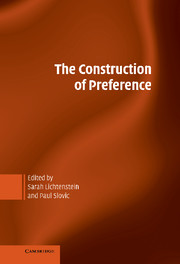Book contents
- Frontmatter
- Contents
- Contributors
- Preface
- Acknowledgments
- I INTRODUCTION
- II PREFERENCE REVERSALS
- III PSYCHOLOGICAL THEORIES OF PREFERENCE REVERSALS
- 6 Contingent Weighting in Judgment and Choice
- 7 Cognitive Processes in Preference Reversals
- 8 The Causes of Preference Reversal
- 9 Preference Reversals Between Joint and Separate Evaluations of Options: A Review And Theoretical Analysis
- 10 Attribute-Task Compatibility as a Determinant of Consumer Preference Reversals
- 11 Preferences Constructed From Dynamic Microprocessing Mechanisms
- IV EVIDENCE FOR PREFERENCE CONSTRUCTION
- V THEORIES OF PREFERENCE CONSTRUCTION
- VI AFFECT AND REASON
- VII MISWANTING
- VIII CONTINGENT VALUATION
- IX PREFERENCE MANAGEMENT
- References
- Index
6 - Contingent Weighting in Judgment and Choice
Published online by Cambridge University Press: 05 June 2012
- Frontmatter
- Contents
- Contributors
- Preface
- Acknowledgments
- I INTRODUCTION
- II PREFERENCE REVERSALS
- III PSYCHOLOGICAL THEORIES OF PREFERENCE REVERSALS
- 6 Contingent Weighting in Judgment and Choice
- 7 Cognitive Processes in Preference Reversals
- 8 The Causes of Preference Reversal
- 9 Preference Reversals Between Joint and Separate Evaluations of Options: A Review And Theoretical Analysis
- 10 Attribute-Task Compatibility as a Determinant of Consumer Preference Reversals
- 11 Preferences Constructed From Dynamic Microprocessing Mechanisms
- IV EVIDENCE FOR PREFERENCE CONSTRUCTION
- V THEORIES OF PREFERENCE CONSTRUCTION
- VI AFFECT AND REASON
- VII MISWANTING
- VIII CONTINGENT VALUATION
- IX PREFERENCE MANAGEMENT
- References
- Index
Summary
The relation of preference between acts or options is the key element of decision theory that provides the basis for the measurement of utility or value. In axiomatic treatments of decision theory, the concept of preference appears as an abstract relation that is given an empirical interpretation through specific methods of elicitation, such as choice and matching. In choice the decision maker selects an option from an offered set of two or more alternatives. In matching the decision maker is required to set the value of some variable to achieve an equivalence between options (e.g., what chance to win $750 is as attractive as 1 chance in 10 to win $2,500?).
The standard analysis of choice assumes procedure invariance: Normatively equivalent procedures for assessing preferences should give rise to the same preference order. Indeed, theories of measurement generally require the ordering of objects to be independent of the particular method of assessment. In classical physical measurement, it is commonly assumed that each object possesses a well-defined quantity of the attribute in question (e.g., length, mass) and that different measurement procedures elicit the same ordering of objects with respect to this attribute. Analogously, the classical theory of preference assumes that each individual has a well-defined preference order (or a utility function) and that different methods of elicitation produce the same ordering of options. To determine the heavier of two objects, for example, we can place them on the two sides of a pan balance and observe which side goes down.
Information
- Type
- Chapter
- Information
- The Construction of Preference , pp. 95 - 121Publisher: Cambridge University PressPrint publication year: 2006
Accessibility standard: Unknown
Why this information is here
This section outlines the accessibility features of this content - including support for screen readers, full keyboard navigation and high-contrast display options. This may not be relevant for you.Accessibility Information
- 1
- Cited by
